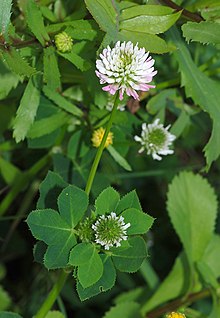Trifolium
| Clover | |
|---|---|
 |
|
| Trifolium sp. (clover) | |
| Scientific classification | |
| Kingdom: | Plantae |
| (unranked): | Angiosperms |
| (unranked): | Eudicots |
| (unranked): | Rosids |
| Order: | Fabales |
| Family: | Fabaceae |
| Subfamily: | Faboideae |
| Tribe: | Trifolieae |
| Genus: |
Trifolium L. |
| Species: | See text |
| Subgenera and Sections | |
|
subg. Chronosemium
|
|
| Synonyms | |
|
Amoria C. Presl |
|
subg. Chronosemium
subg. Trifolium
Amoria C. Presl
Bobrovia A. P. Khokhr.
Chrysaspis Desv.
Lupinaster Fabr.
Ursia Vassilcz.
Xerosphaera Soják
Clover or trefoil are common names for plants of the genus Trifolium (Latin, tres "three" + folium "leaf"), consisting of about 300 species of plants in the leguminous pea family Fabaceae. The genus has a cosmopolitan distribution; the highest diversity is found in the temperate Northern Hemisphere, but many species also occur in South America and Africa, including at high altitudes on mountains in the tropics. They are small annual, biennial, or short-lived perennial herbaceous plants. Clover can be evergreen. The leaves are trifoliate (rarely quatrefoiled, cinquefoil, or septfoil), with stipules adnate to the leaf-stalk, and heads or dense spikes of small red, purple, white, or yellow flowers; the small, few-seeded pods are enclosed in the calyx. Other closely related genera often called clovers include Melilotus (sweet clover) and Medicago (alfalfa or Calvary clover).
Several species of clover are extensively cultivated as fodder plants. The most widely cultivated clovers are white clover Trifolium repens and red clover Trifolium pratense. Clover, either sown alone or in mixture with ryegrass, has for a long time formed a staple crop for silaging, for several reasons: it grows freely, shooting up again after repeated mowings; it produces an abundant crop; it is palatable to and nutritious for ; it fixes nitrogen, reducing the need for synthetic fertilizers; it grows in a great range of soils and climates; and it is appropriate for either pasturage or green composting.
...
Wikipedia
